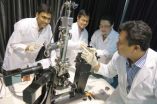(Press-News.org) Using DESY's bright research light sources, scientists have opened a new door to better solar cells, novel superconductors and smaller hard-drives. The research reported in the scientific journal Nature Communications this week enhances the understanding of the interface of two materials, where completely new properties can arise. With their work, the team of Prof. Andrivo Rusydi from the National University of Singapore and Prof. Michael Rübhausen from the Hamburg Center for Free-Electron Laser Science (CFEL) have solved a long standing mystery in the physics of condensed matter. CFEL is a cooperation of DESY, the University of Hamburg and the Max Planck Society.
"Interfaces are a hot topic in materials research," says Rusydi. "If two dissimilar materials are put together, completely new properties may be generated. For instance, two insulators and non-magnetic materials can become metallic and magnetic at their interface." The reason for this change of personality of the two materials is the broken symmetry at the interface, explains Rübhausen, who is a professor at the University of Hamburg. "The two materials have different characteristics and different structures. If you put them together, they have to make a deal and rearrange, and this leads to new properties."
Making use of these phenomena can lead to smaller hard-drives, for example. "Conventional hard-drives are currently controlled by bulk physical properties of the material, for miniaturization we would like to control their physical properties by the interface structure," says Rusydi. "The problem is that we do not yet fully understand what is happening at the interface." As an example, the team investigated the interface of strontium titanate (SrTiO3) and lanthanum aluminate (LaAlO3), two insulators that become conductors at their interface. "However, based on Maxwell's theory, a tenfold higher conductivity should be observed. So, 90 per cent of the charge carriers, the electrons, have gone missing. That was a complete mystery to us," says Rusydi.
In search of the "missing electrons" the scientists used DESY's bright synchrotron radiation source DORIS III to floodlight the interface of the two materials in a wider ultraviolet energy range than any investigation had used before. "All the electrons in the material are like small antenna that respond to electromagnetic radiation at different wavelengths, depending on their energy state," explains Rusydi. The absorption of synchrotron radiation at specific wavelengths reveals the energy state of the corresponding electrons and thus their hiding place in the crystal lattice.
The investigation showed that only a fraction of the expected electrons actually migrate to the interface to form a conducting layer. Most of the electrons redistribute in sub-layers within the lanthanum aluminate, where they were hidden from techniques used in previous investigations. Also, the scientists observed that the transfer of electrons from the crystal to the interface depends on the number of so-called unit cells of lanthanum aluminate in the crystal lattice. A unit cell is the smallest unit of a crystal, this means a crystal can be described as many identical unit cells. If the lanthanum aluminate layer is less than three unit cells thick, all electrons redistribute within the lanthanum aluminate sub-layers and no electrons transfer to the interface anymore which then remains an insulator.
This explains, why more than just one layer is necessary to fully unfold the interface properties. "If only a part of the electrons migrate to the interface, you need a bigger volume to compensate for the symmetry breaking," explains Rusydi. With their work, the scientists can now better understand the behaviour of this and of other interfaces. "In principle, our experimental technique can be used to study any interface," says Rübhausen. "We have only just begun to investigate the basic interface characteristics with it." Although further investigations will have to wait until the Superlumi experimental station that has been used for this work has been moved from the now retired light source DORIS III to DESY's current machine PETRA III. "There currently is no facility in the world that can measure this," Rübhausen says.
The scientists expect that with a better understanding of interfaces, their properties can be more easily tweaked to desired characteristics. "If we learn to control the interface, we can design completely new properties and control them," says Rübhausen.
Deutsches Elektronen-Synchrotron DESY is the leading German accelerator centre and one of the leading in the world. DESY is a member of the Helmholtz Association and receives its funding from the German Federal Ministry of Education and Research (BMBF) (90 percent) and the German federal states of Hamburg and Brandenburg (10 percent). At its locations in Hamburg and Zeuthen near Berlin, DESY develops, builds and operates large particle accelerators, and uses them to investigate the structure of matter. DESY's combination of photon science and particle physics is unique in Europe.
INFORMATION:
Reference
"Mechanisms of charge transfer and redistribution in LaAlO3/SrTiO3 revealed by high-energy optical conductivity"; T.C. Asmara et al.; Nature Communications (2014); DOI: 10.1038/ncomms4663
Scientists open door to better solar cells, superconductors and hard-drives
Research enhances understanding of materials interfaces
2014-04-14
ELSE PRESS RELEASES FROM THIS DATE:
Combs of light accelerate communication
2014-04-14
This news release is available in German.
Miniaturized optical frequency comb sources allow for transmission of data streams of several terabits per second over hundreds of kilometers – this has now been demonstrated by researchers of Karlsruhe Institute of Technology (KIT) and the Swiss École Polytechnique Fédérale de Lausanne (EPFL) in a experiment presented in the journal Nature Photonics. The results may contribute to accelerating data transmission in large computing centers and worldwide communication networks. (DOI: 10.1038/NPHOTON.2014.57.)
The amount of ...
Proteomics International biomarker study closer to a CDx test for diabetic kidney disease
2014-04-14
April 2014, Perth, Australia. Drug discovery company Proteomics International has completed an important milestone towards the development of a companion diagnostic (CDx) test with the validation of several of its protein biomarkers.
The research team authenticated the panel of biomarkers after taking 508 highly curated disease and control samples. Seven biomarkers were validated at high stringency using the company's proprietary mass spectrometry approach.
The mass spectrometry data was then cross-validated using immunoassays in collaboration with the KTH Royal Institute ...
Beneficial organisms react differently to parasite drug
2014-04-14
The substance ivermectin has been used for more than thirty years all over the world to combat parasites like roundworms, lice and mites in humans, livestock and pets. The active ingredient belongs to the chemical group of avermectins, which generally disrupt cell transport and thus attack pests. When ivermectin is excreted in the faeces of treated animals, at overly high doses it also harms dung-degrading beneficial insects like dung beetles and dung flies. This impairs the functioning of the ecosystem. In extreme cases the dung is not decomposed and the pasture is destroyed.
Sensitivity ...
Does germ plasm accelerate evolution?
2014-04-14
Scientists at The University of Nottingham have published research in the leading academic journal Science that challenges a long held belief about the way certain species of vertebrates evolved.
Dr Matt Loose and Dr Andrew Johnson who are experts in genetics and cell development in the School of Life Sciences carried out the research, funded by the Medical Research Council (MRC). It suggests that genes evolve more rapidly in species containing germ plasm. The results came about as they put to the test a novel theory that early developmental events dramatically alter ...
Novel technique developed by NUS scientists opens door to better solar cells
2014-04-14
A team of scientists, led by Assistant Professor Andrivo Rusydi from the Department of Physics at the National University of Singapore's (NUS) Faculty of Science, has successfully developed a technique to study the interface between materials, shedding light on the new properties that arise when two materials are put together.
With a better understanding of how materials interface, scientists can tweak the properties of different materials more easily, and this opens doors to the development of better solar cells, novel superconductors and smaller hard drives.
The ...
Stanford team develops single cell genomics technique to reverse engineer developing lung
2014-04-14
Consider the marvel of the embryo. It begins as a glob of identical cells that change shape and function as they multiply to become the cells of our lungs, muscles, nerves and all the other specialized tissues of the body.
Now, in a feat of reverse tissue engineering, Stanford researchers have begun to unravel the complex genetic coding that allows embryonic cells to proliferate and transform into all of the specialized cells that perform a myriad of different biological tasks.
A team of interdisciplinary researchers took lung cells from the embryos of mice, choosing ...
Saturn's hexagon: An amazing phenomenon
2014-04-14
In 1980 and 1981 NASA's Voyager 1 and 2 space probes passed for the first time over the planet Saturn, located 1,500 million km from the Sun. Among their numerous discoveries they observed a strange, hexagon-shaped structure in the planet's uppermost clouds surrounding its north pole. The hexagon remained virtually static, without moving, vis-à-vis the planet's overall rotation that was not accurately known. What is more, the images captured by the Voyager probes found that the clouds were moving rapidly inside the hexagon in an enclosed jet stream and were being dragged ...
Longer nurse tenure on hospital units leads to higher quality care
2014-04-14
(NEW YORK, NY, April 14, 2014) – When it comes to the cost and quality of hospital care, nurse tenure and teamwork matters. Patients get the best care when they are treated in units that are staffed by nurses who have extensive experience in their current job, according to a study from researchers at Columbia University School of Nursing and Columbia Business School. The study was published in the current issue of the American Economics Journal: Applied Economics.
The review of more than 900,000 patient admissions over four years at hospitals in the Veterans Administration ...
Chemotherapy before or after surgery for high-risk bladder cancer improves survival, but is not routinely administered
2014-04-14
Contrary to treatment guidelines for high-risk bladder cancer, chemotherapy before or after surgery is not commonly used in routine clinical practice. The findings are published early online in Cancer, a peer-reviewed journal of the American Cancer Society.
Clinical trials have shown that survival is improved in patients with muscle-invasive bladder cancer who are given chemotherapy before surgery. There is less evidence about whether chemotherapy after surgery also improves survival. To investigate the use of peri-operative chemotherapy in this disease, Christopher Booth, ...
Celebrity Hairstylist Fateemah Lends Her Talents to "I Am Everything" Benefit Fashion Show
2014-04-14
Award-winning style maven Faatemah has signed on as lead hairstylist for designer Emma Berg's "I Am Everything" benefit fashion event, Tuesday, April 22 at the Ritz Theater. Combining the worlds of fashion and philanthropy, the event will feature Berg's Spring/Summer 2014 collection of prom dresses inspired by 10 senior high school students selected from five Boys & Girls Clubs across the Twin Cities. The young women will walk the runway in the dresses designed exclusively for them.
Faatemah will provide hair styling services and direction, bringing her retro glam ...
LAST 30 PRESS RELEASES:
Interaction of climate change and human activity and its impact on plant diversity in Qinghai-Tibet plateau
From addressing uncertainty to national strategy: an interpretation of Professor Lim Siong Guan’s views
Clinical trials on AI language model use in digestive healthcare
Scientists improve robotic visual–inertial trajectory localization accuracy using cross-modal interaction and selection techniques
Correlation between cancer cachexia and immune-related adverse events in HCC
Human adipose tissue: a new source for functional organoids
Metro lines double as freight highways during off-peak hours, Beijing study shows
Biomedical functions and applications of nanomaterials in tumor diagnosis and treatment: perspectives from ophthalmic oncology
3D imaging unveils how passivation improves perovskite solar cell performance
Enriching framework Al sites in 8-membered rings of Cu-SSZ-39 zeolite to enhance low-temperature ammonia selective catalytic reduction performance
AI-powered RNA drug development: a new frontier in therapeutics
Decoupling the HOR enhancement on PtRu: Dynamically matching interfacial water to reaction coordinates
Sulfur isn’t poisonous when it synergistically acts with phosphine in olefins hydroformylation
URI researchers uncover molecular mechanisms behind speciation in corals
Chitin based carbon aerogel offers a cleaner way to store thermal energy
Tracing hidden sources of nitrate pollution in rapidly changing rural urban landscapes
Viruses on plastic pollution may quietly accelerate the spread of antibiotic resistance
Three UH Rainbow Babies & Children’s faculty elected to prestigious American Pediatric Society
Tunnel resilience models unveiled to aid post-earthquake recovery
Satellite communication systems: the future of 5G/6G connectivity
Space computing power networks: a new frontier for satellite technologies
Experiments advance potential of protein that makes hydrogen sulfide as a therapeutic target for Alzheimer’s disease
Examining private equity’s role in fertility care
Current Molecular Pharmacology achieves a landmark: real-time CiteScore advances to 7.2
Skeletal muscle epigenetic clocks developed using postmortem tissue from an Asian population
Estimating unemployment rates with social media data
Climate policies can backfire by eroding “green” values, study finds
Too much screen time too soon? A*STAR study links infant screen exposure to brain changes and teen anxiety
Global psychiatry mourns Professor Dan Stein, visionary who transformed mental health science across Africa and beyond
KIST develops eco-friendly palladium recovery technology to safeguard resource security
[Press-News.org] Scientists open door to better solar cells, superconductors and hard-drivesResearch enhances understanding of materials interfaces




